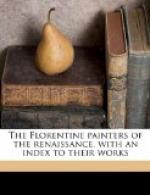And just as his art is life-communicating as is that of scarcely another, so the contemplation of his personality is life-enhancing as that of scarcely any other man. Think that great though he was as a painter, he was no less renowned as a sculptor and architect, musician and improviser, and that all artistic occupations whatsoever were in his career but moments snatched from the pursuit of theoretical and practical knowledge. It would seem as if there were scarcely a field of modern science but he either foresaw it in vision, or clearly anticipated it, scarcely a realm of fruitful speculation of which he was not a freeman; and as if there were hardly a form of human energy which he did not manifest. And all that he demanded of life was the chance to be useful! Surely, such a man brings us the gladdest of all tidings—the wonderful possibilities of the human family, of whose chances we all partake.
Painting, then, was to Leonardo so little of a preoccupation that we must regard it as merely a mode of expression used at moments by a man of universal genius, who recurred to it only when he had no more absorbing occupation, and only when it could express what nothing else could, the highest spiritual through the highest material significance. And great though his mastery over his craft, his feeling for significance was so much greater that it caused him to linger long over his pictures, labouring to render the significance he felt but which his hand could not reproduce, so that he rarely finished them. We thus have lost in quantity, but have we lost in quality? Could a mere painter, or even a mere artist, have seen and felt as Leonardo? We may well doubt. We are too apt to regard a universal genius as a number of ordinary brains somehow conjoined in one skull, and not always on the most neighbourly terms. We forget that genius means mental energy, and that a Leonardo, for the self-same reason that prevents his being merely a painter—the fact that it does not exhaust a hundredth part of his energy—will, when he does turn to painting, bring to bear a power of seeing, feeling, and rendering, as utterly above that of the ordinary painter as the “Mona Lisa” is above, let us say, Andrea del Sarto’s “Portrait of his Wife.” No, let us not join in the reproaches made to Leonardo for having painted so little; because he had much more to do than to paint, he has left all of us heirs to one or two of the supremest works of art ever created.
XII.
[Page heading: BOTTICELLI]
Never pretty, scarcely ever charming or even attractive; rarely correct in drawing, and seldom satisfactory in colour; in types, ill-favoured; in feeling acutely intense and even dolorous—what is it then that makes Sandro Botticelli so irresistible that nowadays we may have no alternative but to worship or abhor him? The secret is this, that in European painting there has never again been an artist so indifferent




